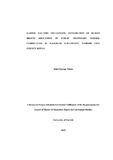| dc.description.abstract | Human rights are those rights that belong to all human being everywhere in the
world. They are universal, inalienable, indivisible and interdependent. Each
person irrespective of status or any other factor has rights which should not be
infringed for peace and prosperity within the society to be realized. It is against
this background that nations have integrated human right education in their
curriculum. However, despite efforts to integrate human rights education in the
school curriculum, levels of human right awareness among the students and
teachers in many countries is wanting and teachers still violates some of these
rights. Therefore, this study sought to investigate school factors affecting human
rights integration in public secondary schools in Kasarani sub-county, Nairobi
city county, Kenya. The variables investigated included, students and teachers’
level of human right awareness, teachers’ perception towards teaching of human
rights education, instructional resources and teaching strategies. The study
adopted descriptive survey design which involved `selecting a sample from the
population and on that basis inferences are made about the population from which
it is drawn. The population included 1303 form three students and 280 teachers
from the public secondary schools at Kasarani Sub-County. Students were
selected using stratified random sampling to get a sample of 298 forms three that
were included as participants in this study. Teachers were selected using
purposive sampling technique to obtain a sample of 40 teachers who were
History, Christian Religious Education, and Life Skills teachers. Research
instrument used in this study were open and closed ended questionnaires.
Qualitative data was analyzed using content analysis and quantitative data was
analyzed using descriptive statistics. The result indicated that instructional
resources for teaching human right were inadequate. Teachers used lecture
method to teach human right education. Teacher’s perception towards human
right education was positive though many had low self-efficacy due to lack of
training on how to teach human right education. The students showed high level
of human rights awareness with the internet being a major contributor to this
awareness. The following recommendations were made. School administration to
provide adequate instructional resources, integration of aspects of human right in
Key subjects relevant to the topic, carrying out of in-service and pre-service
courses on human right to increase teacher’s confidence, teachers to use students
centered and interactive teaching strategies for quality integration of Human
Rights Education in Secondary school curriculum in Kenya. | en_US |

